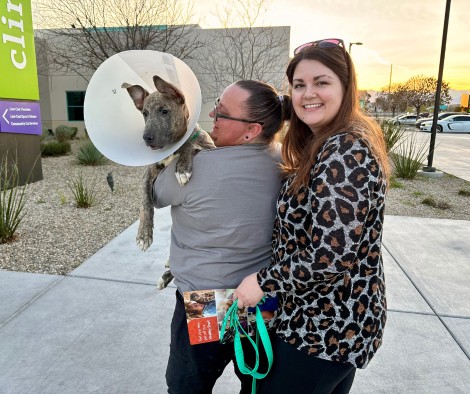
Sam Stocking was fast asleep one night when the insulin pump attached to her body stopped working. A person with Type 1 diabetes, Stocking used a continuous glucose monitor, which beeped an alert but failed to rouse her or her husband. Without the insulin, Stocking says she likely would've been hospitalized.
Knowing something was wrong, her Labrador retriever Korey started licking her and eventually jumped onto the bed—and onto her—to wake her up, allowing her to fix the issue.
"He's saved my life several times," she says.
Stocking, who lives in central Illinois, was diagnosed with Type 1 diabetes when she was 4 years old. Ever since, managing her blood sugar levels has been a constant balancing act. As she progressed into her 20s, Stocking says she stopped being able to feel when her blood sugar would spike or dip until it reached dangerous levels, necessitating the installation of her first continuous glucose monitor five years ago.
Frustrated with the sometimes finicky technology in the monitor and worried she and her husband might sleep through a glucose alarm in the middle of the night, Stocking reached out to her doctor about getting more help. That led her to Korey.
Stocking's doctor gave her the number of a trainer who could explain the benefits of a diabetic alert dog and how Stocking could find her own. She found a litter of purebred Labrador retrievers in 2019, and that's when she first met 1-week-old yellow Lab Korey.
Bridget Evans is 'Ready for Anything' With Her Labradors at Her Side
Training Korey
She pored through books, watched YouTube videos, and, through a little trial and error, found a successful method for her and Korey.
"It is possible to do it yourself," she says. "It's a lot of work, but it's possible and it is actually so rewarding when you see 'OK, we've done all this work, and now it's really paying off because he is amazing and he's doing his job and he loves it.'"
Having a well-trained diabetic alert dog can be a game changer for people managing diabetes.
"If my blood sugar gets too low, I can have seizures, I can faint, I can go into a coma if it's serious enough," Stocking says.
Helping Others
Seeing how rewarding it was training Korey—and discovering firsthand just how much of a difference an alert dog made in her own life—inspired Stocking to help others in the same situation. She earned her dog trainer certification and founded Korey the Kanine, where Stocking helps other people with diabetes train their alert dogs through the same techniques that helped her and Korey become such a good team.
"The training that diabetic alert dogs receive is a lot of scent training," she says. "So you collect scent samples from high and low blood sugars, and you simulate having those blood sugars and training the dog to come to you and do the specific alert."
(Korey, for instance, boops Stocking with his nose when her blood sugar is too low. He spins in circles when it's too high.)
"We do a lot of fainting training, we do a lot of public access training: having a dog that can sit under a table at a restaurant without getting up and trying to steal everybody's food."
Here's Why It's Not OK to Pet Service Dogs (and What You Should Do Instead)
Now almost 3 years old, the "lovable, goofy" Korey has become an integral part of Stocking's life, going everywhere she does and not only keeping her safe but serving as a lovable companion.
"Just in general, having a dog around makes me happier," she says. "You always have your best friend with you."





